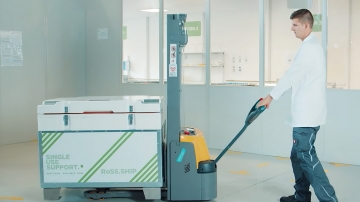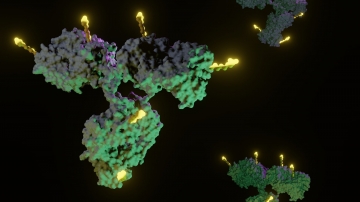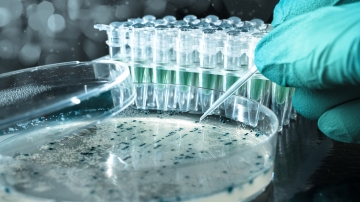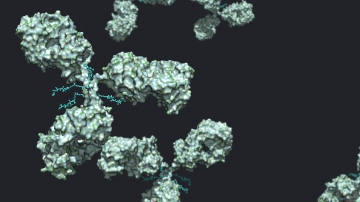Bioconjugation simply explained
Table of contents
ShowBioconjugation has become a common method to link small molecular fragments with special properties with much larger and more complex biomolecules like proteins, antibodies, nucleic acids and even cells.
The two most important reasons to do this are: to make the biomolecule easier to detect and/or quantify in a complex matrix by labeling methods, e. g. fluorescent labels in diagnostics and assays, and to use the properties of the biomolecule for therapeutic applications, e. g. using monoclonal antibodies’ outstanding specificity to carry highly potent cytotoxins to pathogenic cells in antibody drug conjugates (ADCs).
This article will give a broad overview of bioconjugates: what they are, how they are made and what they are used for.
Bioconjugation – the definition
Bioconjugation is defined as the linking of two specific components by covalent chemical bonds, wherein one component is a biological polymer (peptide, complex carbohydrate, nucleic acid) and the other one is a small molecule with particular properties (fluorescent dye1, radioactive probe2, nuclear spin label3, highly potent pharmaceutical activity4).
Bioconjugates are characterized by having a linkage group between the two major components that are connected by exploiting reactive functional groups, such as nucleophilic amino acid residues of lysine or cysteine. 1 2 3 4
Components and structure of bioconjugates
While the biomolecule component of bioconjugates is generally from one of the three big biopolymer families (protein, oligosaccharide, nucleic acid), the structures of possible linkers and small molecule components are extremely varied.
This is clear for the small molecule components: due to their many different functions and properties, they span large and varied chemical and structural spaces. Even more diverse are pharmaceutically active compounds that are used in antibody drug conjugates.
The structure of the linker has been almost neglected during the beginning years of bioconjugation, but nowadays big development efforts are expended for the design of optimal linker structures. Classic examples are flexible alkyl chains and more hydrophilic polyethylene glycol (pegylation), modern linkers in ADCs facilitate bond cleavage near or in the target tissue to selectively trigger pharmaceutical activity.
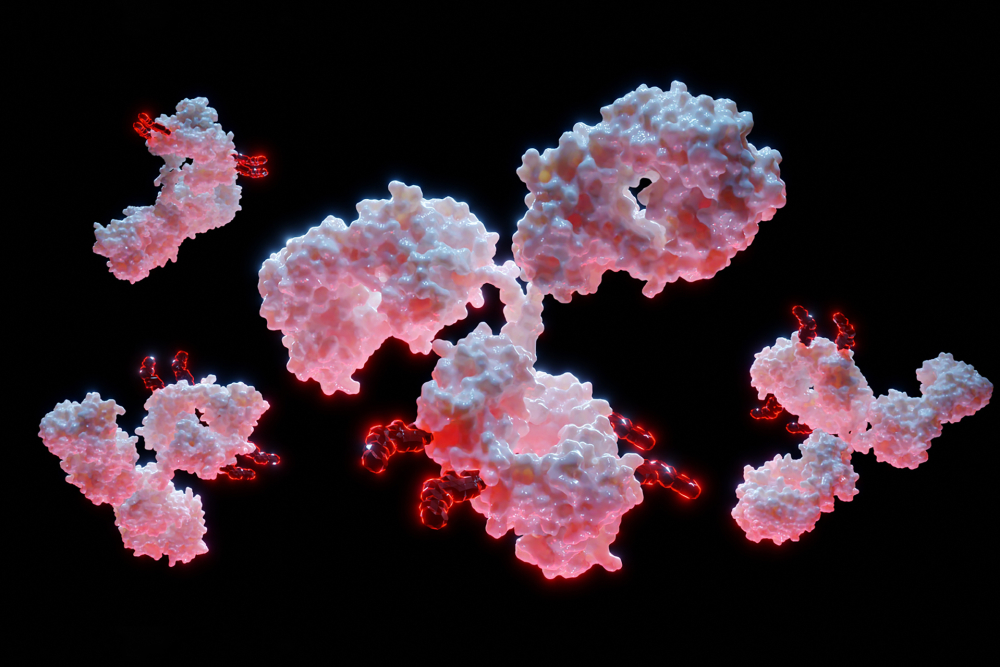
Synthesis – the principle of bioconjugation
The principle of bioconjugation is chemical synthesis, which describes the process of combining two or more molecules to form a new type of substance. The synthesis of bioconjugates from proteins and enzymes is especially challenging, due to the large amount of building blocks (over 20, for nucleic acids: 4).
The bioconjugation strategy to generate a well behaved product must consider the chemical biology and biochemistry restraints of the project: Is site-selective conjugation required? Are living cells present during the bioconjugation reaction? The answers to these questions narrow down the choice of reagents and bioconjugate techniques. The scientists Stephanopoulos and Francis published a method to choose the optimal bioconjugation chemistry.5
Frequent combinations in bioconjugation
As the term “bioconjugate” already suggests, bioconjugation is all about combining different chemical and/or biological substances. In order to create bioconjugates that suit their purpose, it is important to highlight which combinations are feasible in the first place.
Due to the structure of the involved biomolecules for bioconjugation and well established toolbox of organic chemistry, some combination types are very well suited for bioconjugation. Here, we want to focus on protein substrates because they are of particular interest in the development of therapeutic bioconjugates.
Biochemists leverage on already present reactive sites in the protein: nucleophilic centers in amino acid side chains of cysteine and lysine which contain a thiol and amine group respectively:
- cysteine + thiol = disulfide
- lysine + NHS-ester = amide
In recent years, novel chemical approaches have been developed in order to establish new combinations in bioconjugates:
- cycloadditions with catalysis, between alkynes and azides (click chemistry)
- additions to maleimides
- modification of tryptophan
- oxidation followed by reactions of aldehydes to form oximes and hydrazones
- ligation to nanoparticles
- use of biotin and derivatives as a label (very good ligand for avidin)
For these specialized protein conjugation approaches, very mild reaction conditions were developed, i. e. suitability for aqueous solutions and even chemoselective reactions in vivo, although protein modifications may be required as a starting point.6
Applications of bioconjugation
Bioconjugation has become an indispensable tool for many crucial applications in life sciences.
- basic research: characterization of intermolecular interactions, e. g. profiling of tyrosine kinase catalysts that are involved in signal transduction
- diagnostics: the crosslinking of extremely sensitive sensors to biomolecules allowed the development of very valuable assays and imaging techniques that are widely used in diagnostic medicine
- therapeutics: antibody drug conjugates allowed the development of targeted therapies, that leverage on the extreme specificity of antibodies to carry pharmaceutically active payloads to tissues of interest, e. g. accumulation of cytotoxic agents in cancer cells
Antibody-Drug Conjugates – a result of bioconjugation
One frequent example of bioconjugation is the production of ADCs. Antibody-Drug Conjugates are applications of bioconjugation with tremendous impact on medicine and pharmaceutical sciences: Current ADC technology allows to treat patients with substances that are much too potent for conventional application: their side effects on healthy tissue would be severe. Conjugation of such substances to antibodies with high affinity to e. g. cancerous cells concentrates their effect on pathologic tissue and spares healthy cells.
The high toxicity of these therapeutics leads to challenges in their production, transport to healthcare centers and administering them. Clearly, their potency poses high restrictions on the fluid management of ADCs. Their beneficial effects for many patients is well worth the effort to overcome them and businesses are already offering innovative solutions.
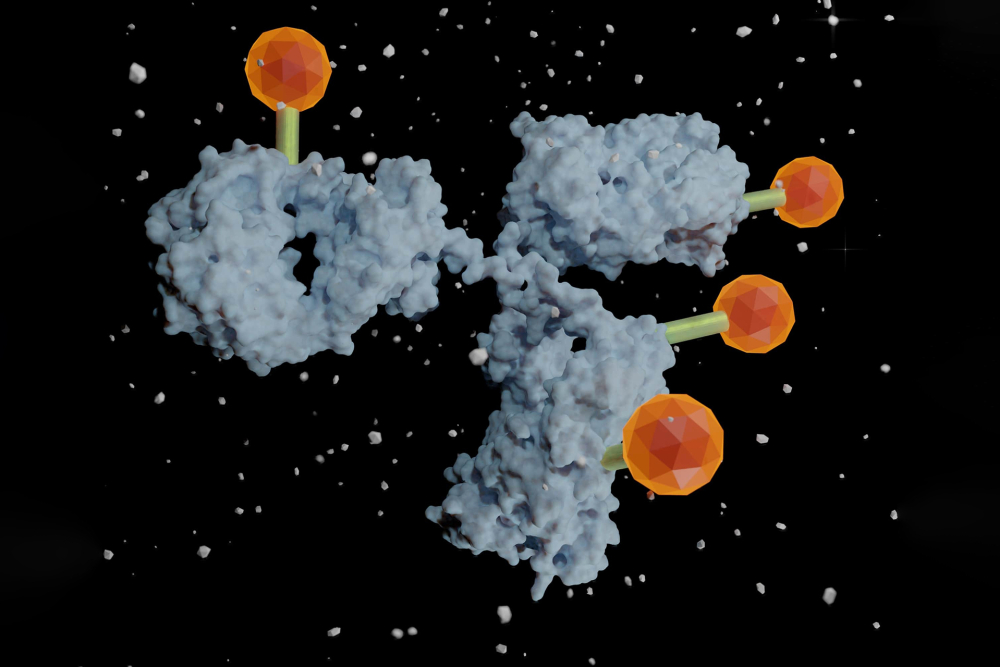
Challenges in bioconjugation
Indeed, the development of pharmaceutical bioconjugates leads to several challenges pertaining to the high structural complexity, chemical sensitivity and very potent pharmaceutical activity.
Due to the delicate antibody component, controlled freezing of ADCs is a commonly employed method to preserve the highest quality of production intermediates and finished drug substances. While this seems simple at first glance, uncontrolled freezing may be a cause of degradation and the actual implementation requires developmental efforts to establish validated freezing and thawing protocols with dedicated plate freezing platforms.
These issues expand to the transport and storage of Antibody-Drug Conjugates. Many ADCs require ultra-cold conditions during storage and transport, thus necessitating specialized storage containers and ideally protective cases to prevent damage, leakage and exposure to the environment.
Intense research with a promising outlook
ADCs and other bioconjugates are going to be key players in the biopharmaceutical industry sector. Big pharma companies are expecting a multi-billion dollar market for the coming years and numerous start-ups are investing great efforts into the development of innovative approaches to bioconjugates.7
Therefore, the need for service providers to overcome issues specific to bioconjugate research, development and production is continuously growing.
A holistic approach is the implementation of bioconjugate manufacturing with single-use technologies because disposable equipment combined with integrated platform systems solves many regulatory and operative issues.
Manufacturing plants gain flexibility and agility due to minimal set-up time and post-production clean up labor. Integrated liquid handling systems allow completely closed processes to minimize contamination as well as exposure risks.
The adaptation of single-use technologies offers a highly promising approach to simplify research, development and manufacture of bioconjugates, as is evidenced by increasing cooperations of major players with innovative single-use technology providers.7
- Sensitive Immunofluorescent Detection of the PRAME Antigen Using a Practical Antibody Conjugation Approach, http://dx.doi.org/10.3390/ijms222312845, Published 2021-12-01
- Site-specific chelator-antibody conjugation for PET and SPECT imaging with radiometals, http://dx.doi.org/10.1016/j.ddtec.2018.10.002, Published 2018-10-25
- Paramagnetic Chemical Probes for Studying Biological Macromolecules, http://dx.doi.org/10.1021/acs.chemrev.1c00708, Published 2022-01-27
- Antibody drug conjugate: the “biological missile” for targeted cancer therapy, http://dx.doi.org/10.1038/s41392-022-00947-7, Published 2022-03-22
- Choosing an effective protein bioconjugation strategy, http://dx.doi.org/10.1038/nchembio.720, Published 2011-11-16
- Bioorthogonal Chemistry: Fishing for Selectivity in a Sea of Functionality, http://dx.doi.org/10.1002/anie.200900942, Published 2009-08-27
- The top 10 antibody-drug conjugate contenders in 2021, https://www.fiercepharma.com/special-report/top-10-antibody-drug-conjugate-contenders-2021, Published 2021




